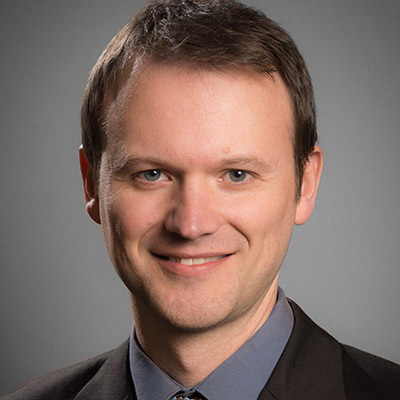Emory University and Emory School of Medicine faculty have accomplished major milestones in science, technology, engineering and math (STEM) research, from investigating new protein-related changes in Alzheimer’s patients’ brains to building a robotic fish powered by human heart cells.
Snails with schistosomiasis

Assistant Professor of Biology David Civitello. Photo courtesy of Emory University
Assistant Professor of Biology David Civitello studies how snail competition leads to fewer parasites that cause schistosomiasis, a disease caused by infected animals or human feces contaminating freshwater. The disease enters the human bloodstream and eventually migrates to the liver, intestines and other organs. Snails, however, reduce the parasites that cause schistosomiasis.
Civitello’s hypothesis countered the environmental science community’s long-held belief that the transmission of schistosomiasis increases with snail abundance.
“Most of my research is inspired by the interest to use ecological theory to contribute to understanding how parasites spread in host populations and how parasite transmission can be controlled,” Civitello said. “This work synthesizes these efforts at the population scale, which is relevant for human risk of infection and for designing useful interventions to disrupt transmission.”
Civitello supported his hypothesis through triangulating mathematical modeling, or the division of a polygon surface into a series of triangles, of individual snail metabolism, which he refers to as “calorie counting” for hosts and parasites. He also conducted field surveys of schistosomes and snails in 24 villages near Mwanza, Tanzania.
The key takeaway Civitello discovered was that the disease transmission risk is highest when the snail population is scarce and has plentiful access to food, which are common conditions but were previously dismissed as insignificant.
Biohybrid fish

Sung Jin Park, an assistant professor at the Wallace H. Coulter Department of Biomedical Engineering at the Georgia Institute of Technology and Emory. Photo courtesy of Emory University
Emory faculty also collaborate with universities across the United States and globally to enhance their projects.
Sung Jin Park, an assistant professor at the Wallace H. Coulter Department of Biomedical Engineering at the Georgia Institute of Technology and Emory, worked with scientists from Harvard University (Mass.) to construct a biohybrid fish. They used two layers of living human heart muscle cells, allowing the fish’s tail to move from side to side. The closed-loop system of the fish’s contractions replicates the mechanics of a beating human heart.
The biohybrid fish project stemmed from Park’s previous research involving a biohybrid stingray. The initial model of the biohybrid stingray required continuous stimulation from blue light in order to swim. Park and his team developed the biohybrid fish with the intention of increasing the speed and longevity of the fish’s ability to swim.
“In 2016, I published the biohybrid stingray,” Park said. “At the time, instead of using the optogenetic technique, [we] basically expressed the liaison protein in the cardiomyocyte and then used the light stimulation to control the muscle movements. We continually stimulate[d] the heart muscle cells with the light.”
Through self-sustaining muscle excitations and contractions, the biohybrid fish swam for up to 108 days. Park hopes that this research will lead to advancements in cardiovascular technology, such as pacemakers.
Alzheimer’s disease

Assistant Professor of Neurology Erik Johnson. Photo courtesy of Emory University
The School of Medicine is also the site of new research on protein-related changes in the brains of Alzhimer’s patients. Assistant Professor of Neurology Erik Johnson utilized tandem-mass-tag mass spectrometry, a method that labels proteins by employing chemical tags with different heavy isotopes, to identify a greater number of low-abundance proteins versus label-free techniques.
While Alzheimer’s research has been primarily focused on the amyloid protein, Johnson noted that clearing amyloid protein from the brain has not worked so far in clinical trials. Johnson collaborated with the Accelerating Medicines Partnership in order to develop alternative therapeutic approaches.
Johnson measured 8,600 proteins across about 500 brains of subjects who either had Alzheimer’s when they died, did not have the disease or had a similar brain pathology to Alzheimer’s patients but were cognitively intact or in the early stage of the disease. The proteins analyzed were sorted into 44 different groups based on similar functions. Johnson specifically focused on the M42 matrisome module, which appeared to be highly correlated to facets of Alzheimer’s disease.
“We saw that this matrisome module seemed to be a clutch of proteins in the early and late stages of the disease,” Johnson said. “We also saw that a lot of these proteins were correlated to these amyloid plaques in the brain, and the proteins that associate with the amyloid may be good drug targets rather than the amyloid itself.”
Johnson and his team are still uncertain about what happens to the proteins when they associate with plaques, specifically whether they gain a toxic function or lose their normal function. However, Johnson’s future research aims to further study the detrimental impacts of the matrisome on the brain.
Psychological factors, breast reconstruction surgery complications

Albert Losken, a professor of surgery and the program director of the division of plastic and reconstructive surgery. Photo courtesy of Emory University
Albert Losken, a professor of surgery and the program director of the division of plastic and reconstructive surgery, focuses on how psychological factors related to the body affect the risk of complications after breast reconstruction surgery.
“We do a lot of studies doing pre- and post-op, but we thought what we would do in this group of patients is to just look at the pre-op because of those quality of life in patient satisfaction domains there is a satisfaction with their breasts, outcome and care,” Losken said. “We thought we would look at their satisfaction with their breasts to see if that is a predictor of how they would do after surgery in terms of complications.”
Losken analyzed the psychological states of 302 women who have undergone a post-mastectomy breast reconstruction by administering a validated BREAST-Q questionnaire assessing body image. The women also rated their dissatisfaction with their bodies when unclothed to observe if there is an association between body dissatisfaction and an increased risk of postoperative complications.
“We found that patients who reported they were less happy before the surgery with the way their bra fit and the way they looked in the mirror unclothed were more likely to, after surgery, have delayed wound healing,” Losken said.
Although surgeons cannot control how women perceive their bodies, the results of this study could help plastic surgeons prepare for possible complications that may arise from surgery. Losken said that addressing psychological factors related to body image prior to surgery has a similar effect to other therapies used to reduce patient-related risks, such as losing weight and quitting smoking.
Global Diabetes Center
Emory continues to promote STEM research by funding and developing new research labs and centers; an example is increasing funding for the Emory Global Diabetes Research Center (EGDRC) at the Rollins School of Public Health. Executive Director K.M. Venkat Narayan and Co-Director Mohammed Ali said that EGDRC will employ innovative, interdisciplinary research to improve the metabolic health of those in Georgia and across the U.S.
“The goal of EGDRC is to recognize its campus-wide function in promoting and conducting interdisciplinary domestic and global diabetes research and training across … Emory … and the domestic and international partners of EGDRC,” Narayan said.
In addition to developing a world-class research center, Emory is dedicated to promoting diversity among its faculty as well as further increasing student engagement in research.
“We are engaging in a strategic planning process that includes many of Emory’s most talented and diverse faculty who engage in diabetes research,” Ali said. “Beyond this, we will work toward improving our dissemination, expanding opportunities for students and supporting innovative ideas.”
Science & Research Desk | Julia Laszcz (she/her 24C) is from Bergen County, New Jersey, majoring in neuroscience and behavioral biology and English. Outside of the Wheel, Laszcz is a writer for Grey Matters. Laszcz also is a volunteer for her town’s ambulance corp. She likes to cook new recipes and play with her dog.






